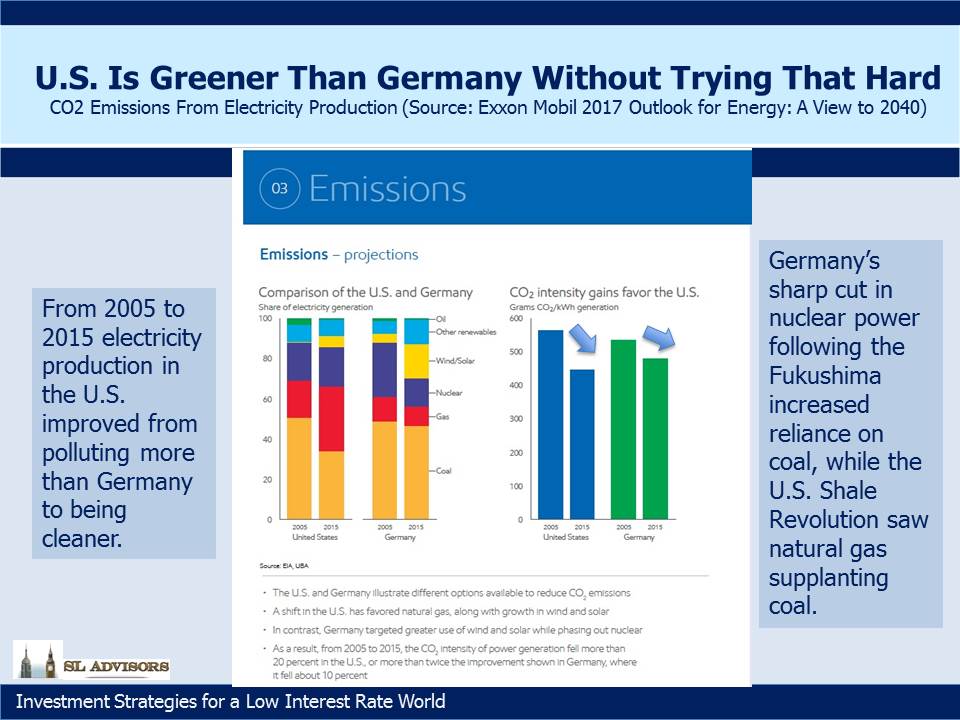It’s Not Easy Being Green
Recently in A Few Thoughts on Long Term Energy Use we included the striking chart shown again below comparing CO2 emissions from power generation in the U.S. and Germany. It elicited quite a few comments from readers because it showed that Germany is now lagging behind the U.S. on this metric. Germany has set out to be a global leader in the use of renewables. By 2050 they aim to generate 80% of their electricity from renewables and to cut their greenhouse gas emissions by up to 95%. Until 2015, Germany had the world’s largest installed solar capacity, which reflects quite a commitment because there are plenty of sunnier places on the planet than northern Europe. The push to renewables (dubbed “Energiewende”, or Energy Transition, in German) enjoys widespread public support, which extends as far as surcharges on household electricity. German consumers pay among the highest prices for electricity in the world, largely due to taxes and other charges in support of renewables.
By contrast, the U.S. has a more ambivalent view. Strong opinions are not hard to find on both sides of the debate over whether global warming is man-made. Some states, notably California, have implemented policies to reduce emissions as they became frustrated with inaction by the U.S. Congress. President Obama sought to impose stricter regulation on emissions through executive actions, but President Trump has said the U.S. will withdraw from the Paris Agreement on Climate Change. American public opinion doesn’t reflect the same concern about the issue as Germany. And yet, measured by CO2 output per unit of electricity, we’re doing better. Lower U.S. emissions come with cheaper electricity which stimulates economic growth.
The Shale revolution is certainly part of the reason. Abundant, cheap, clean-burning natural gas has been steadily replacing dirtier coal as the fuel of choice for power plants. In October (the most recent figures available) 33% of U.S. electricity produced came from natural gas, about 1% ahead of coal. Renewables were 15%, of which hydroelectric is just over a third. The rivers and waterfalls whose flows can be harnessed have long been identified, so don’t expect hydro to grow much. Solar and wind were 7.5%, up from 5.9% a year ago. Germany’s solar and wind contributed 18.2% of their power generation, although by consumption it was less because they export some of this clean electricity (see below).
Germany’s Energiewende faces two problems. The first is common to solar and wind everywhere – it’s not always sunny and windy. Since it’s still not currently possible to store large amounts of electricity cheaply for later use, conventionally powered baseload electricity capacity is required. Germany’s shutting down many of their nuclear reactors following Japan’s 2011 Fukushima disaster increased their reliance on coal to ensure a certain minimum amount of electricity is available. Around 12% of Germany’s electricity is generated by natural gas, and while it might make sense to increase this, Russia is their biggest supplier. Greater reliance on Russia’s Gazprom would synchronize disruptive pipeline maintenance with periods of policy disagreement between the two countries.
Their second problem is that wind power comes from the northern part of the country and Baltic Sea, while it’s needed in the south. Today’s north-south transmission capability is inadequate to move what’s generated.
A further unexpected consequence of the move to renewables has been distortions in Germany’s electricity market. At times the operators of windfarms have been paid to stop electricity generation since the spot price has gone negative. At other times Germany has exported cheap electricity to neighboring countries such as Poland, Czech Republic and Austria, which some claim has impeded those countries’ ability to develop local renewable energy sources.
The German government has taken steps to moderate near term growth of renewable capacity while the transmission network is brought into better alignment with output. None of the problems Germany is facing seem insurmountable over the long term, and America’s relatively greener credentials will probably be challenged. But given the political support for current policies in Germany, it’s notable how challenging they’re finding it to execute successfully.
